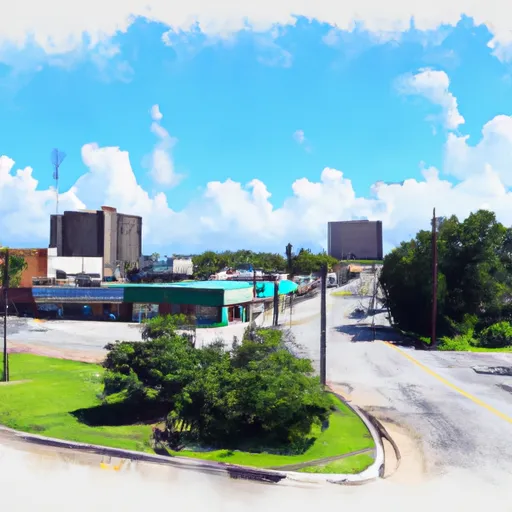-
 Snoflo Premium
Snoflo Premium
Get unlimited access to all our content
With no Ad interruptions! - Start Your Free Trial Login with existing account
Jennings
Eden Index
Climate
7.8
•
Recreation
4.8
•
Community
•
Safeguard
4.8/10

Jennings, Florida is a small town located in Hamilton County, in the northern part of the state. The region experiences a humid subtropical climate, characterized by hot and humid summers, mild winters, and abundant rainfall throughout the year. Summers in Jennings can be quite hot, with temperatures often reaching the 90s°F (32°C), while winters are generally mild, with highs in the 60s°F (15-20°C).
Jennings is situated near the Suwannee River, which plays a significant role in the area's hydrology. The river provides opportunities for fishing, boating, and other water-based activities. Additionally, there are several nearby natural springs, such as the famous Madison Blue Spring and the Suwannee Blue Spring, where visitors can enjoy swimming, snorkeling, and diving in crystal-clear waters.
Outdoor recreation enthusiasts can take advantage of the numerous recreational opportunities available in Jennings and its surroundings. The region offers ample opportunities for hiking, camping, and wildlife observation in the nearby state parks and forests. Jennings is also known for its hunting opportunities, with various game species like deer, turkey, and small game attracting hunters from across the state.
Overall, Jennings, Florida provides a pleasant climate, diverse hydrology constituents, and a wealth of outdoor recreation opportunities for residents and visitors alike.
What is the Eden Index?
The Snoflo Eden Index serves as a comprehensive rating system for regions, evaluating their desirability through a holistic assessment of climate health, outdoor recreation opportunities, and natural disaster risk, acknowledging the profound impact of these factors on livability and well-being.
Climate Health Indicator (CHI): 7.8
Jennings receives approximately
1310mm of rain per year,
with humidity levels near 81%
and air temperatures averaging around
20°C.
Jennings has a plant hardyness factor of
8, meaning
plants and agriculture in this region tend to thrive here all year round.
By considering the ideal temperature range, reliable water supplies, clean air, and stable seasonal rain or snowpacks, the Climate Health Indicator (CHI) underscores the significance of a healthy climate as the foundation for quality living.
A healthy climate is paramount for ensuring a high quality of life and livability in a region, fostering both physical well-being and environmental harmony. This can be characterized by ideal temperatures, reliable access to water supplies, clean air, and consistent seasonal rain or snowpacks.
Weather Forecast
Streamflow Conditions
Suwannee
Area Rivers
Suwannee
Snowpack Depths
Suwannee
Reservoir Storage Capacity
Suwannee
Groundwater Levels
Recreational Opportunity Index (ROI): 4.8
The Recreational Opportunity Index (ROI) recognizes the value of outdoor recreational options, such as parks, hiking trails, camping sites, and fishing spots, while acknowledging that climate plays a pivotal role in ensuring the comfort and consistency of these experiences.
Access to outdoor recreational opportunities, encompassing activities such as parks, hiking, camping, and fishing, is crucial for overall well-being, and the climate plays a pivotal role in enabling and enhancing these experiences, ensuring that individuals can engage in nature-based activities comfortably and consistently.
Camping Areas
| Campground | Campsites | Reservations | Toilets | Showers | Elevation |
|---|---|---|---|---|---|
| Manatee Springs State Park | None | 25 ft | |||
| Shell Mound County Park | None | 7 ft | |||
| Suwannee River State Park | None | 74 ft | |||
| Gornto Springs County Park | 24 | 20 ft | |||
| Otter Springs County Park | 100 | 19 ft | |||
| Hinton Landing County Park | None | 19 ft | |||
| Hart Springs | None | 13 ft | |||
| Shired Creek County Park | None | 11 ft | |||
| Gibson | None | 65 ft | |||
| Horseshoe Beach County Park | None | 9 ft |
Catastrophe Safeguard Index (CSI):
The Catastrophe Safeguard Index (CSI) recognizes that natural disaster risk, encompassing floods, fires, hurricanes, and tornadoes, can drastically affect safety and the overall appeal of an area.
The level of natural disaster risk in a region significantly affects safety and the overall livability, with climate change amplifying these risks by potentially increasing the frequency and intensity of events like floods, fires, hurricanes, and tornadoes, thereby posing substantial challenges to community resilience and well-being.
Community Resilience Indicator (CRI):
The Community Resilience Indicator (CRI) recognizes that education, healthcare, and socioeconomics are crucial to the well-being of a region. The CRI acknowledges the profound impact of these elements on residents' overall quality of life. By evaluating educational resources, healthcare accessibility, and economic inclusivity, the index captures the essential aspects that contribute to a thriving community, fostering resident satisfaction, equity, and social cohesion.

